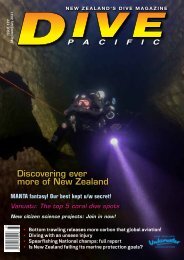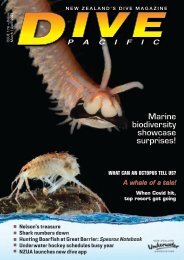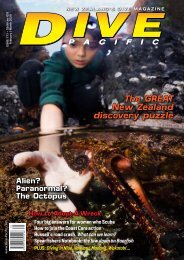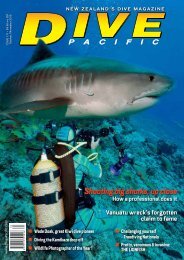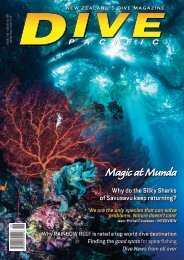Dive Pacific 175 Dec2020 Jan 2021
Dive Pacific, New Zealand's Dive Magazine , captures the best of diving in New Zealand and the Pacific. with adventures, top photos and expert technical advice
Dive Pacific, New Zealand's Dive Magazine , captures the best of diving in New Zealand and the Pacific. with adventures, top photos and expert technical advice
Create successful ePaper yourself
Turn your PDF publications into a flip-book with our unique Google optimized e-Paper software.
SPECIESFOCUS<br />
Clown toado<br />
~Canthigaster callisterna<br />
By Paul Caiger<br />
The clown toado or sharp-nosed pufferfish is<br />
a species of sub-tropical origin distributed<br />
throughout eastern Australia and the southwest<br />
<strong>Pacific</strong> up to New Caledonia.<br />
In New Zealand, whilst abundant at the Kermadecs,<br />
it is also found in the north, especially in places<br />
where the tropical currents reach (that is, islands and<br />
headlands). Recent evidence suggests the species is<br />
becoming more common at these places, likely as a<br />
result of the warming seas around New Zealand.<br />
The clown toado is a member of a very diverse genus<br />
of pufferfishes, being one of 36 Canthigaster species.<br />
It’s brightly coloured, green above and white below,<br />
with two dark parallel stripes running along the body<br />
and covered in iridescent blue wavy lines and dots<br />
throughout. In courting males, the dark stripes fade<br />
completely and the blues and greens become more<br />
vivid (as depicted in the photograph).<br />
Males are territorial and likely to breed with<br />
females exclusively within their territory,<br />
defending their boundaries against other males.<br />
Like other pufferfishes, the clown toado possesses<br />
one of the most potent naturally occurring toxins.<br />
This neurotoxin called tetradotoxin (named after<br />
the pufferfish family) is present in the skin and<br />
other tissues of the fish, thus making it unpalatable<br />
to predators. Their ability to ‘puff’ or inflate<br />
themselves with water, together with their<br />
poisonous skin and tissues, explains why these<br />
small, slow-moving, colourful fish are often found<br />
out in the open sand and rubble environs and not<br />
predated upon by large piscivorous predators such<br />
as snapper.<br />
~Canthigaster callisterna<br />
1 Also known as a sharp-nosed pufferfish or 6<br />
clown toby.<br />
2 Found in northern New Zealand but also 7<br />
Australia and the SW <strong>Pacific</strong>.<br />
3 15-20 cm in length.<br />
8<br />
4 One of 36 species in the genus Canthigaster.<br />
5 Males defend territories, primarily for breeding.<br />
Males display extravagant colouration during<br />
courting.<br />
Containing the pufferfish-specific neurotoxin,<br />
tetrodotoxin which is highly poisonous if ingested.<br />
Like all pufferfishes, will inflate itself with water<br />
to become 3-4 times its size when alarmed.<br />
56 <strong>Dive</strong> New Zealand | <strong>Dive</strong> <strong>Pacific</strong>




